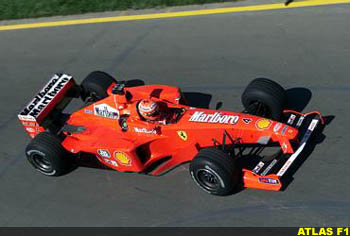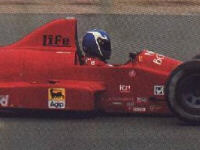 |
|
| The F1 FAQ | |
| by Mark Alan Jones, Australia | |
|
Have a question about Formula One statistics or history? Well you're not the only one, and it's about time someone came up with the answers to Formula One's most Frequently Asked Questions. Send us your questions, to faq@atlasf1.com - we may not know everything, but we will sure make the effort to find out
"At the Grand Prix in Australia, there were yellow lines all around the circuit, whereas there were no yellow lines to the one in Brazil. Would you be able to tell me when those yellow lines were introduced and for what purpose are they?"
In poor weather it can sometimes be very hard for a driver to distinguish between darkish coloured tarmac and darkish coloured grass. You need to know where the corners are. However, at Albert Park there are white lines everywhere because it's a street circuit. All the lines which indicate where usual traffic is supposed to go. So the circuit edge lines at Albert Park are painted yellow so they don't get confused with the existing white lines. And by the way, when I watched the CART round at Long Beach street circuit last week I noticed they used a red line.
"Ok explain this: David Coulthard had a stalled engine at the start of the Brazilian grand Prix. The race marshalls were seen pushing him off the track. Then, the McLaren boys got it fixed up and sent him on his (not so) merry way. Granted he was 3 laps down and eventually suffered fatal transmission problems, but the question is - why was he allowed to restart since he received outside assistance? And if this was a violation of the rules, has anyone (Ferrari) filed a protest? And if they did, what are the possible consequences for DC and McLaren?" Bit of a naughty one but yeah, Coulthard did receive illegal assistance from race officials it would seem. There is a provision in the rules which does allow for assistance from the Marshalls if the car is in a dangerous position and can be quickly restarted. As for a penalty? Well since Coulthard failed to finish there is no effective penalty that can be applied. A dollar fine would be a slap on the wrist, and fining McLaren points would be overtly harsh as Mika Hakkinen, an innocent party in this incident, would also be penalised but that.
"What is the story with Yamaha engines will they be back in the near future? Paul T"
F1 is unfinished business for the Japanese motorcycle manufacturer but unless they gather the corporate will to win again it's unlikely they'll be back. And without a major car production to support, it would be a questionable marketing policy anyway.
"Which Grand Prix qualifying session had the closest gap ever between the pole position holder and the last man on the grid? Deano, Australia" On ya Deano. My Atlas F1 colleague, Marcel Schot, wanted to look this one up and this is what he found: If you include only cars that started the race, then the smallest gap is a mere 1.80 seconds between Jack Brabham's Brabham and Mario Andretti's March in 1970 at the Spanish Grand Prix at Jarama. Andretti was 19th on the grid, 20th and last Rolf Stommelen, didn't record a time so maybe this doesn't count. Next is 1.87 seconds between James Hunt's McLaren and final qualifier Patrick Neve's Williams run March at the 1977 British Grand Prix at Silverstone. However, if you insist on the smallest gap between quickest and slowest then the answer changes again, because of car which failed to qualify. If all cars are considered and not just the qualifiers, then the closest was the 1977 Japanese Grand Prix at the Mount Fuji circuit - pole man Mario Andretti (Lotus) was 2.78 seconds clear of Alex Ribeiro (March).
"In 1990, Life Racing team (in Brazilian GP, driven by David brabham, today racing for Panoz GT Team) ran with a W12 cylinder design. 1) Was that the first try for a revolutionary F1 engine design among the "V" and the 'boxsters' blocks? 2) Does that engine have some connection with this W12 Volkswagen engine used for it's sports car? Ary K M, Sao Paolo, Brazil."
Gary Brabham - unlike older brother Geoff, younger brother David, and father Jack - has now retired and no longer races. Veteran Bruno Giacomelli replaced him but there was never an improvement in the team's performance. The VW sports car W12 motor is an actual 'W' shape of 4 banks of three cylinders. The Life W12 was far from the first revolutionary engine design. In the mid 60's BRM ran a design called the H16 which was two V8's one above and one below. In 1972 Lotus experimented with a Gas Turbine engine, similar to what's used in helicopters, ships and some tanks.
"I wonder if could you clarify the blue flag rule for a friend and me. He says that a driver will only be blue flagged if he is being lapped, whereas I can see where the same could apply when drivers are on the same lap. For example, a front runner who stalled at the start of the warm-up lap would have to start from the rear, like Schumacher at Australia. However a driver of his skill would be able to storm back into the points within not too many laps. So if he came up to a driver well down in the positions, (anywhere from say 10th to 2nd last) but on the same lap, who was clearly slower, would he be blue flagged if he blatantly did not let the driver through? The answer will cost my friend or me a pint! Thank you George" The blue flag rule revolves around the basic KISS principle - Keep It Simple Stupid. If a blue flag is held out towards a driver there is a car following closely behind. If that flag is then waved, then there is a car overtaking. It's asking a bit much of the flag marshalls to expect them to keep track of the position of each car on the track so they don't wave blue flags at positional battles. It's hard enough to tell the difference between team-mates on TV. At ground level and at speed? Forget it. That car trying overtake? Wave a blue at it. Having said that, I must correct a hidden assumption in your question: when it comes to battling for positions, cars - even if they are much slower than those behind them - do not have any obligation whatsoever to move over for an overtake. By all means, we expect them to fight for their position to the best of their abilities. That's what racing is all about. Otherwise, would you have expected Schumacher to move over for Hakkinen in the Brazilian Grand Prix two weeks ago? After all, it was blatantly obvious his Ferrari was much slower than Mika's McLaren. The fact that they were battling for the second position and not the tenth or the 15th, makes no difference. A position is a position no matter where. And with the current rate of attrition, a 15th place at the opening stages of a race could well be a podium by the end of it... Hey, do I get a pint for providing the answer? I'll have a Kilkenny Draught, thanks!
|
| Mark Alan Jones | © 1999 Kaizar.Com, Incorporated. |
| Send questions and comments to: faq@atlasf1.com | Terms & Conditions |


